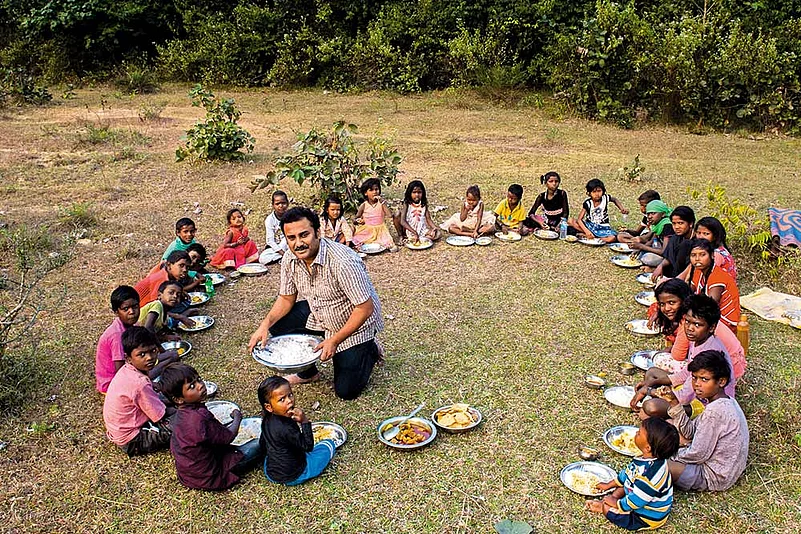It was July 6, 2015, eight-year-old Srideep’s birthday. His parents, Chandrima and Cha----ndra Sekhar Kundu, had splurged on a party for him. In the end, there were masses of leftover food that even the cat--ering men were unable to polish off. Much of it was trashed.
Nutrition Warriors | How Chandra Sekhar Kundu Managed To Serve 90,000 Plates From Waste Food
Chandra Sekhar Kundu's organisation FEED works in the Asansol, Calcutta belt. The CISF and IIM-Calcutta have joined hands in Kundu's crusade to fill empty stomachs

Later that night, Chandra Sekhar witnessed a scene that changed his life: two children rummaging for food in a garbage dump. One stood guard with a stick to fend off stray dogs; the other foraged the heap. On closer look, he realised, they were having biriyani—polishing off the rice and storing bits of meat in a plastic bag, to savour later. Stricken with remorse, Chandra Shekhar brought them home, gave them something to eat, but could not sleep that night.
On the internet, he chanced upon some shocking stats: One-third of the world’s hungry and malnourished live in India, yet India wastes 40 per cent food produced. That means, Rs 89,060 crore worth of food a year, or Rs 244 crore a day. Compared to that, the Centre’s mid-day meal scheme, covering 12 crore children in 11.4 lakh schools, works on a paltry annual budget of around Rs 10,000 crore. He made his mind up: “I decided that I have to do something to stop this colossal wastage and make sure children don’t go hungry in this country. The mid-day meal scheme…provides just one meal.”? ?
A computer science teacher at an engineering college in Asansol, West Bengal, Chandra She-k-har bought a tiffin career and sta-r-ted taking exc-ess food from the college canteen to children living near the railway station. With his students, he started making short films on food wastage, uploading them on YouTube, along with Facebook posts. Within a month they went viral.
Then, he filed a RTI petition before the Food Corporation of India and learnt that around 22,000 metric tonnes of grain had been was-ted in 2014-15 . He then wrote to the Presi-dent of India, highlighting two agendas: One was to take measures against food wastage at FCI; the other was to start a campaign to stop wastage of cooked food. The FCI responded, mentioning a few steps they would take to stop food grain wastage.
Enthused, Kundu set up FEED (Food Education and Economic Development), a nonprofit, in 2016, along with colleagues to address the second agenda. Donations and cash were not accepted. “I am not into it to make money and don’t want people to get that impression.” Members of FEED felt they did not want to eng-age with restaurants and hotels for food. “They store food for very long,” adds Kundu. “We don’t serve stale food to children.”
Initially, FEED volunteers used to collect food—themselves or via intermediaries—from office can--teens, hostels, medical and police establishments. Over time, a more sustainable mechanism was created. “We now connect people with excess food to those who need it the most,” explains Kundu, “so they can get the food themselves to certain designated spots.” Apart from his stud-ents and colleagues, the biggest support came from manufacturing firm Vesuvius India in Calcutta, IIM-Calcutta, the Central Industrial Security Force (CISF) barracks and the Indian Institute of Paediatricians, with its 25,000 members. ?
FEED has evolved a range of programmes—from opening ‘protein clubs’ and food racks for citizens for leaving pre-packaged food and fruits, to setting up evening schools and libraries, cooking fresh food for street children, teaching them about food education and nutrition to footpath dispensaries, which reputed doctors visit.
The power of hope is real: from a humble beg-inning, FEED has now scaled up to cover about 350 children across Asansol, Calcutta and rec-ently Delhi every day. The dream is to save over one lakh plates of food from wastage every year. “We have already saved over 90,000 plates,” says Kundu with a smile.
Also Read:
By Damayanti Datta in Asansol
-
Previous Story
 'Anti-Constitutional, Against Law': Siddaramaiah On Karnataka Governor's Prosecution Sanction Against Him
'Anti-Constitutional, Against Law': Siddaramaiah On Karnataka Governor's Prosecution Sanction Against Him - Next Story


















